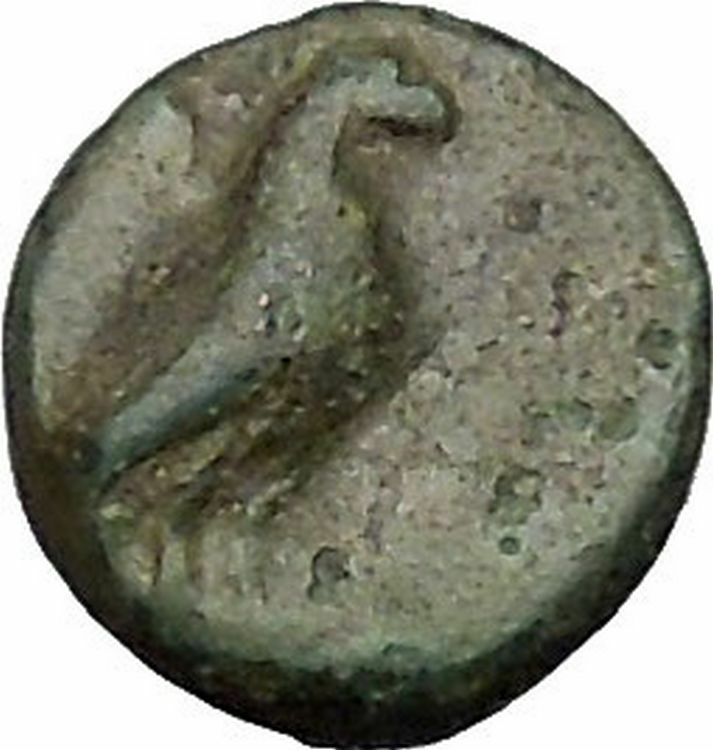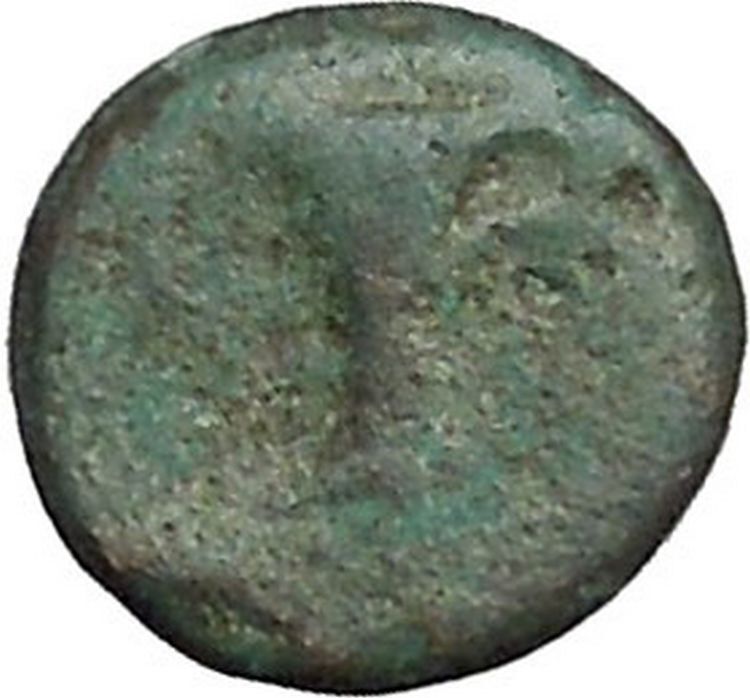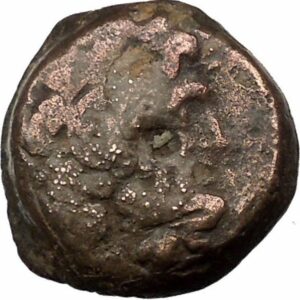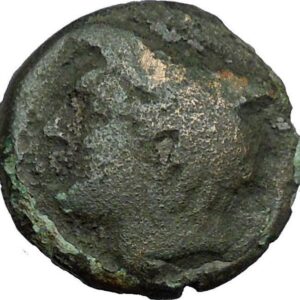|
Greek city of Thessalonica in Macedonia
Bronze 16mm (4.76 grams) – Struck 158-149 B.C.
Reference: Sear 1468; B.M.C. 5.24
Diademed head of Artemis right.
ΘEΣΣAΛO / NIKEΩΝ – Strung bow behind quiver;
monogram to left.
You are bidding on the exact item pictured,
provided with a Certificate of Authenticity and Lifetime Guarantee of
Authenticity.
The bow and arrow is a projectile
weapon
system (a bow with
arrows
) that predates
recorded history
and is common to most
cultures
.
Archery
is the art, practice, or skill of
applying it.

Description
A bow is a flexible arc which shoots aerodynamic projectiles called
arrows
. A string joins the two ends of the bow
and when the string is drawn back, the ends of the bow are flexed. When the
string is released, the potential energy of the flexed stick is transformed into
the velocity of the arrow.
Archery
is the art or sport of shooting arrows
from bows.
Today, bows and arrows are used primarily for
hunting
and for the sport of
archery
. Though they are still occasionally
used as weapons of war
, the development of
gunpowder
and
muskets
, and the growing size of armies, led to
their replacement in warfare several centuries ago in much of the world.
Someone who makes bows is known as a
bowyer
, and one who makes arrows is a
fletcher
—or in the case of the manufacture of
metal arrow heads, an arrow smith.
History

Scythians
shooting with bows,
Panticapeum
(known today as
Kertch
,
Ukraine
), 4th century BCE.
The bow and arrow is among the oldest composite projectile weapons invented;
only
spear throwers
and
darts
may predate it, having been in use since
30,000 BCE, with the oldest example from 17,500 BCE. However, despite its
ancient provenance, a number of cultures in historical times lacked the bow and
arrow, and in others
oral history
records a time before its
acquisition.
The earliest potential arrow heads date from about 64,000 years ago in the
South African
Sibudu Cave
, though their identification as
arrowheads (as opposed to
spear
or
dart
heads) is uncertain. The first actual bow
fragments are the Stellmoor bows from northern Germany. They were dated to about
8,000 BCE but were destroyed in
Hamburg
during the Second World War, before
carbon 14 dating
was available; their age is
attributed by archaeological association. The oldest bows in one piece are the
elm
Holmegaard bows
from
Denmark
which were dated to 9,000 BCE. High
performance wooden bows are currently made following the Holmegaard design.
The bow and arrow are still used in tribal warfare in
Africa
to this day. An example was documented
in 2009 in Kenya
when the
Kisii-tribe
and
Kalenjin-tribe
clashed resulting in four
deaths.
Construction

Polychrome small-scale model of the archer XI of the west pediment
of the
Temple of Aphaea
, ca. 505–500 BCE.
Parts of the bow
The basic elements of a bow are a pair of curved
elastic
limbs
, traditionally made from
wood, joined by a riser. Both ends of the limbs are connected by a
string known as the
bow string
. By pulling the string backwards the
archer
exerts
compressive force
on the string-facing section,
or
belly
, of the limbs as well as placing the
outer section, or
back
, under
tension
. While the string is held, this stores
the energy later released in putting the arrow to flight.[citation
needed] The force required to hold the string
stationary at full draw is often used to express the power of a bow, and is
known as its draw weight, or weight. Other things being equal, a higher draw
weight means a more powerful bow, which is able to project arrows heavier,
faster, or a greater distance.
The various parts of the bow can be subdivided into further sections. The
topmost limb is known as the upper limb, while the bottom limb is the lower
limb. At the tip of each limb is a nock, which is used to attach the bowstring
to the limbs. The riser is usually divided into the grip, which is held by the
archer, as well as the arrow rest and the bow window. The arrow rest is a small
ledge or extension above the grip which the arrow rests upon while being aimed.
The bow window is that part of the riser above the grip, which contains the
arrow rest.
In bows drawn and held by hand, the maximum draw weight is determined by the
strength of the archer. The maximum distance the string could be displaced and
thus the longest arrow that could be loosed from it, a bow’s draw length, is
determined by the size of the archer.
A composite bow
uses a combination of materials
to create the limbs, allowing the use of materials specialized for the different
functions of a bow limb. The classic composite bow uses wood for lightness and
dimensional stability in the core, horn to store energy in compression, and
sinew
for its ability to store energy in
tension. Such bows, typically Asian, would often use a stiff end on the limb
end, having the effect of a recurve.[16]
In this type of bow, this is known by the Arabic name ‘siyah’.
Modern construction materials for bows include
laminated
wood,
fiberglass
,
metals
, and
carbon fiber
components.
Arrows
An arrow usually consists of a shaft with an arrowhead attached to the front
end, with fletchings and a nock at the other. Modern arrows are usually made
from carbon fibre, aluminum, fiberglass, and wood shafts. Carbon shafts have the
advantage that they do not bend or warp, but they can often be too light weight
to shoot from some bows and are expensive. Aluminum shafts are less expensive
than carbon shafts, but they can bend and warp from use. Wood shafts are the
least expensive option but often will not be identical in weight and size to
each other and break more often than the other types of shafts. Arrow sizes vary
greatly across cultures and range from very short ones that require the use of
special equipment to be shot to ones in use in the
Amazon River
jungles that are 8.5 feet (2.6
metres) long. Most modern arrows are 22 inches (56 cm) to 30 inches (76 cm) in
length.
Arrows come in many types, among which are breasted, bob-tailed, barrelled,
clout, and target. A breasted arrow is thickest at the area right behind the
fletchings, and tapers towards the nock and head. A bob-tailed arrow is thickest
right behind the head, and tapers to the nock. A barrelled arrow is thickest in
the centre of the arrow. Target arrows are those arrows used for target shooting
rather than warfare or hunting, and usually have simple arrowheads.
Arrowheads
The end of the arrow that is designed to hit the target is called the
arrowhead. Usually, these are separate items that are attached to the arrow
shaft by either tangs or sockets. Materials used in the past for arrowheads
include flint, bone, horn, or metal. Most modern arrowheads are made of steel,
but wood and other traditional materials are still used occasionally. A number
of different types of arrowheads are known, with the most common being
bodkins
, broadheads, and piles. Bodkin heads
are simple spikes made of metal of various shapes, designed to pierce armour. A
broadhead arrowhead is usually triangular or leaf-shaped and has a sharpened
edge or edges. Broadheads are commonly used for hunting. A pile arrowhead is a
simple metal cone, either sharpened to a point or somewhat blunt, that is used
mainly for target shooting. A pile head is the same diameter as the arrow shaft
and is usually just fitted over the tip of the arrow. Other heads are known,
including the blunt head, which is flat at the end and is used for hunting small
game or birds, and is designed to not pierce the target nor embed itself in
trees or other objects and make recovery difficult. Another type of arrowhead is
a barbed head, usually used in warfare or hunting.
Bowstrings
Bowstrings may have a nocking point marked on them, which serves to mark
where the arrow is fitted to the bowstring before firing. The area around the
nocking point is usually bound with thread to protect the area around the
nocking point from wear by the archer’s hands. This section is called the
serving. At one end of the bowstring a loop is formed, which is permanent. The
other end of the bowstring also has a loop, but this is not permanently formed
into the bowstring but is constructed by tying a knot into the string to form a
loop. Traditionally this knot is known as the archer’s knot, but is a form of
the timber hitch
. The knot can be adjusted to
lengthen or shorten the bowstring. The adjustable loop is known as the “tail”.
Bowstrings have been constructed of many materials throughout history,
including fibres such as
flax, silk
, and
hemp. Other materials used were animal
guts
, animal
sinews
, and
rawhide
. Modern fibres such as
Dacron
or
Kevlar
are now used in bowstring construction,
as well as steel wires in some compound bows.
Compound bows
have a mechanical system of
pulley cams over which the bowstring is wound.
Types of bows
There is no one accepted system of classification of bows. Some systems
classify bows as either longbows or composite bows. In this system, a longbow is
any bow that is made from one material. Composite bows are made from two or more
layers of different materials. Other classifications divide bows into three
types — simple, backed, and composite. In this scheme, simple bows are made of
one material, backed bows are made of two layers, which could be similar or
different materials. Composite bows are made of three different layers, usually
different materials, but occasionally two of the layers are made from the same
material.
Common types of bow include
-
Recurve bow
: a bow with the tips curving
away from the archer. The curves straighten out as the bow is drawn and the
return of the tip to its curved state after release of the arrow adds extra
velocity to the arrow.
-
Reflex bow
: a bow that curves completely
away from the archer when unstrung. The curves are opposite to the direction
in which the bow flexes while drawn.
- Self bow
: a bow made from one piece of
wood.
- Longbow
: a self bow that is usually quite
long, often over 5 feet (1.5 metres) long. The traditional
English longbow
was usually made of
yew
wood, but other woods are used also.
-
Composite bow
: a bow made of more than one
material
-
Compound
: a bow with mechanical aids to
help with drawing the bowstring. Usually, these aids are pulleys at the tips
of the limbs.
Crossbow
In a crossbow
, the limbs of the bow, called a
prod, are attached at right angles to a crosspiece or
stock
in order to allow for mechanical pulling
and holding of the string. The mechanism that holds the drawn string has a
release or trigger that allows the string to be released. A crossbow shoots a
“bolt” rather than an arrow.
Artemis was one of
the most widely venerated of the Ancient Greek deities. Some scholars believe
that the name, and indeed the goddess herself, was originally pre-Greek. Homer
refers to her as Artemis Agrotera,
Potnia Theron
< Artemis of the wildland,
Mistress of Animals”. In the classical period of
Greek mythology
, Artemis (Greek:
(nominative)
Ἄρτεμις, (genitive)
Ἀρτέμιδος) was often
described as the daughter of
Zeus and Leto
, and the twin sister of
Apollo
. She was the Hellenic goddess of the
hunt, wild animals, wilderness, childbirth, virginity and young girls, bringing
and relieving disease in women; she often was depicted as a huntress carrying a
bow and arrows. The deer
and the
cypress
were sacred to her. In later
Hellenistic times, she even assumed the ancient role of
Eileithyia
in aiding childbirth.
Artemis later became identified with
Selene
, a
Titaness
who was a Greek moon goddess,
sometimes depicted with a crescent moon above her head. She was also identified
with the Roman goddess
Diana
, with the
Etruscan
goddess
Artume
, and with the Greek or
Carian
goddess
Hecate
.
The city was founded around
315 BC
by the
King
Cassander of Macedon
, on or near the site of the ancient town of
Therma
and
twenty-six other local villages. He named it after his wife
Thessalonike
, a half-sister of
Alexander the Great
. She gained her name (“victory of Thessalians”: Gk
nikē
“victory”) from her father,
Philip II
, to commemorate her birth on the day of his gaining a victory over
the
Phocians
, who were defeated with the help of
Thessalian
horsemen, the best in Greece at that time. Thessaloniki developed
rapidly and as early as the
2nd
century BC
the first walls were built, forming a large square. It was an
autonomous part of the Kingdom of
Macedon
, with its own parliament where the King was represented and could
interfere in the city’s domestic affairs.
Roman
era
After the fall of the kingdom of Macedon in
168 BC
,
Thessalonica became a city of the
Roman Republic
. It grew to be an important trade-hub located on the
Via
Egnatia
, the
Roman road
connecting
Byzantium
(later
Constantinople
), with
Dyrrhachium
(now Durrës
in
Albania
), and
facilitating trade between Europe and Asia. The city became the capital of one
of the four Roman districts of Macedonia; it kept its privileges but was ruled
by a praetor
and had a Roman garrison, while for a short time in the
1st
century BC
, all the Greek provinces came under Thessalonica (the Latin form
of the name). Due to the city’s key commercial importance, a spacious harbour
was built by the Romans, the famous Burrowed Harbour (Σκαπτός Λιμήν) that
accommodated the town’s trade up to the eighteenth century; later, with the help
of silt deposits from the river
Axios
, it was
reclaimed as land and the port built beyond it. Remnants of the old harbour’s
docks can be found in the present day under Odos Frangon Street, near the
Catholic Church.
Thessaloniki’s
acropolis
,
located in the northern hills, was built in
55 BC
after
Thracian
raids in the city’s outskirts, for security reasons.
The city had a
Jewish
colony, established during the
first
century
, and was to be an early centre of
Christianity
. On his second missionary journey,
Paul
of Tarsus
, born a Hellenized Israelite, preached in the city’s synagogue,
the chief synagogue of the Jews in that part of Thessaloniki, and laid the
foundations of a church. Other Jews opposed to Paul drove him from the city, and
he fled to
Veroia
. Paul wrote two of his
epistles
to the Christian community at Thessalonica, the
First Epistle to the Thessalonians
and the
Second Epistle to the Thessalonians
.
Thessaloníki acquired a patron saint,
St. Demetrius
, in 306. He is credited with a number of miracles that saved
the city, and was the Roman
Proconsul
of Greece under the anti-Christian emperor
Maximian
,
later martyred at a Roman prison where today lies the
Church of St. Demetrius
, first built by the Roman sub-prefect of
Illyricum
Leontios in 463. Other important remains from this period include
the
Arch and Tomb of Galerius
, located near the centre of the modern city.
|












